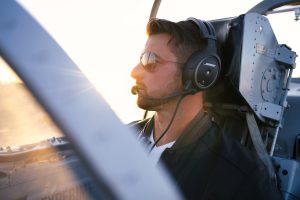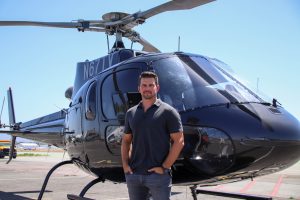- Slug: BC-CNS-Top Gun Aerial Coordinator, 1,585 words.
- 3 photos and captions below.
- 1 video here.
By Dexter Zinman
Cronkite News
LOS ANGELES – When most people turn 14, they start dreaming about learning to drive and what their first car might be.
But at 14, Kevin LaRosa II already was up in the air.
“For aviation, I started logging time at 14 years of age, I soloed in helicopters and airplanes at 16, and got my license at 17,” said LaRosa, the aerial coordinator and camera pilot for the hit film “Top Gun: Maverick,” told Cronkite News.
LaRosa is vice president of production at Helinet, a helicopter service provider adjacent to Van Nuys Airport, but his main gig is as an aerial coordinator in films. He’s a member of the Screen Actors Guild and the Motion Picture Pilots Association.
On “Top Gun: Maverick,” LaRosa worked on the ground and in the air, flying jets with the cinematography crew inside to capture the critically acclaimed aerial scenes and helping run the rigorous flight training for the cast, led by Tom Cruise as Capt. Pete “Maverick” Mitchell.
LaRosa’s decades of career experience on film sets is a huge reason for the film’s acclaim, but he’s quick to credit the uniqueness of “Top Gun: Maverick’s” overall production.
“Our cast literally basically had to learn how to fly,” LaRosa said. Every aircraft in the film is a real plane, he said, piloted by a real human.
Training actors for actual flight isn’t unheard of, but it certainly isn’t common, LaRosa said, even on big-budget action films. “Top Gun: Maverick’s” cast training blew any comparable out of the water.
“It’s not normal,” La Rosa said. “This is very unique to ‘Top Gun: Maverick,’ and that’s why I think the movie is doing so good – is because we did all these incredible, unique, expensive things that most people wouldn’t do.”
The film has made more than $900 million worldwide since May 27.
One of the major reasons for the intense level of training was Cruise, who starred as “Maverick” Mitchell in 1986’s “Top Gun.”
“Tom’s an incredible performer, but he’s also an incredible aviator,” LaRosa said. “He knew, especially from the first movie in 1986, what it would take to be inside the F-18s and still be able to deliver an amazing performance.”
LaRosa said Cruise was a driving force behind getting the cast so highly trained.
“You can’t just hire an amazing cast and throw them in an F-18,” LaRosa said. “They’re going to get sick, their performances will be degraded because they’re going to have these physiological effects of g-forces. … Tom knew that they needed to be trained to a level that actors are never trained for aviation.”
Once they were trained, the cast members “were like seasoned veterans,” he said.
“There have been plenty of movies in the past where the cast got aviation experience,” LaRosa said. “But nothing to this extent. This was serious. This was heavy duty.”
Family influence
Along with LaRosa’s decades of experience, his family background in film aviation came in handy on “Top Gun: Maverick.”
“I’m a third-generation pilot, second-generation aerial coordinator and stunt pilot,” he said. “I don’t think I would do what I do today if I didn’t have my father and my grandfather who did what they did.”
LaRosa, 36, said his aviation journey was never in question.
“We were literally looking at pictures of me as a baby riding in warbirds and airplanes sitting on my dad’s lap,” he said. “Of course, I don’t remember that … my first memory of flying with him is probably in grade school.”
LaRosa regularly traveled with his dad, Kevin LaRosa Sr., to airshows and other events. Once his father entered the film business, tagging along was a no-brainer.
“I got in the movie industry totally by accident,” LaRosa Sr. recalled. “We happened to have an old airplane that I was restoring, and one day a location guy found me out at the airport and asked me to fly it in this TV show. And that was the first ‘Incredible Hulk’ TV series.”
“I started working on film sets with him,” the younger LaRosa said. “So I got the love for filmmaking and aviation at a very early age.”
“He’s what I always refer to as a natural,” LaRosa Sr. said of his son. “And thank God for that because there are some people who have to work a little bit at it.”
Although his film work has taken LaRosa across the country and around the world, he had to work his way up the ranks.
“At a young age, I was in a support role,” LaRosa said. “I was driving the fuel truck for the helicopter, I was cleaning the airplanes and helicopters.”
Then he began applying his ability to fly, his father recalled.
“When he saw the need … to move an aircraft or helicopter into position to do camera work, he just naturally fell right into that,” LaRosa Sr. said. “So he learned all about various lenses and angles and things that are important to us today as far as lighting and getting a beautiful shot – but also how to recognize the safest way to do it.”
The younger LaRosa finally got to fly on film in the early 2000s, but he had been on sets since the mid-1990s, including for “Independence Day.”
“The first movie I actually flew in was ‘Mr. & Mrs. Smith,’” he said.
His support roles on film sets helped with some of his work on “Top Gun: Maverick.”
“There’s a lot of things that I’ve taken from my father and other colleagues and other idols in the aviation industry,” LaRosa said. “I remember on ‘Pearl Harbor,’ I wasn’t really involved that much, I was younger, but I got to watch my dad teach a lot of the actors.”
LaRosa’s father also continues to work in the film industry. His most recent credit is as a flight double in the 2021 film “Army of the Dead.”
But he’s most proud of his son.
“As far as I can tell, he’s the most versatile of any movie pilot,” he said. “Flying all the various equipment that he can fly – and do it so gracefully.”
LaRosa credits being in a support role for helping him find his own path in the industry, instead of just being the guy who worked on movies with his dad.
“I was unwavered in my goal to get to where I am today, but my path was not a straight line,” LaRosa said. “In fact, the guy I (idolized), my dad, pulled me aside one day on a movie set when I was 17 and said, ‘Listen, bud, if you ever want to do what I do, seriously, professionally and be respected, you’re going to have to leave the industry.’”
His dad wanted to make sure he got his own experiences, and that meant LaRosa leaving the film industry for a while to gain more senior piloting and aviation experience.
“There’s nothing better than education when it comes to anything,” LaRosa Sr. said, “but in aviation, the more experience you can get, flying various aircrafts and flying with different pilots, you learn to pick up the good and the bad.”
LaRosa recalled his father telling him that he would need to become “your own person, your own aviator, your own pilot, because nobody will ever trust you if you’re just a junior.”
It turned out to be sound advice – even if it was hard to hear. LaRosa flew everything from medical helicopters to charter jets.
“Things can’t just be handed to you,” he said. “You’ve got to go work for it. … My role expanded to be what I’ve always wanted to be. Jets, helicopters, airplanes, warbirds: I wanted to be an aerial coordinator and stunt pilot.”
Teaching actors to fly in ‘Maverick’
Part of that dream role involved teaching Cruise and the other actors in “Top Gun: Maverick” the ins and outs of flying F-18s – and how to deal with g-forces.
“Most people don’t understand g-force,” LaRosa said. “We can see it in Top Gun, people’s faces kind of get distorted. If we’ve been on a roller coaster, and most people have, and it does a corkscrew and you get pressed into your seat, that’s g-force.
“And we’re feeling maybe 2, 2½ (g’s) on a roller coaster. Our cast regularly felt 8. That’s like 2,000 pounds of force.”
Despite the challenge and expense of producing the film in a unique way, he said the studio felt it was worth it to get the best performances out of the cast.
“Know that every time we see a jet or anything on camera in ‘Top Gun: Maverick,’ there’s a real aircraft there,” LaRosa said. “Every time we see a cast member in a cockpit, they’re in an F-18 doing those maneuvers. And that’s I think why the world is really watching this movie and feeling what they feel, because it’s not a cartoon, this is really happening.”
LaRosa Sr. said his son is “producing unbelievable aerial photography.”
“I’m so proud of him when I look at his work. … I couldn’t be a prouder father with my son following in my shoes, and actually be better than I ever was.”
Three generations of aviation have led to this work, and “Top Gun: Maverick” was an experience LaRosa will never forget.
“I’m honored to have made that,” LaRosa said. “I’m honored to have raised the bar for aerial cinematography. I love that I got to play a part in it.”
For more stories from Cronkite News, visit cronkitenews.azpbs.org.


